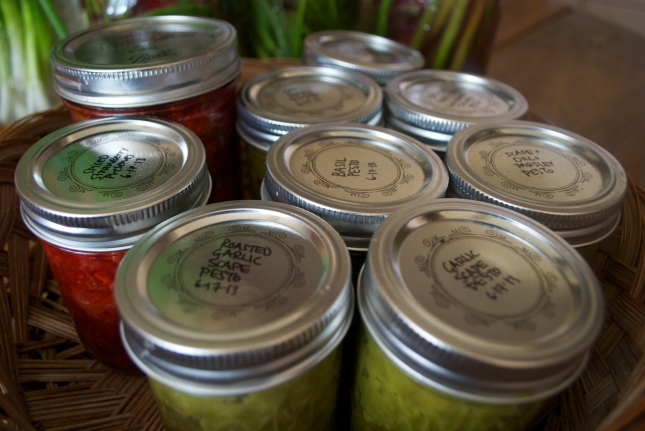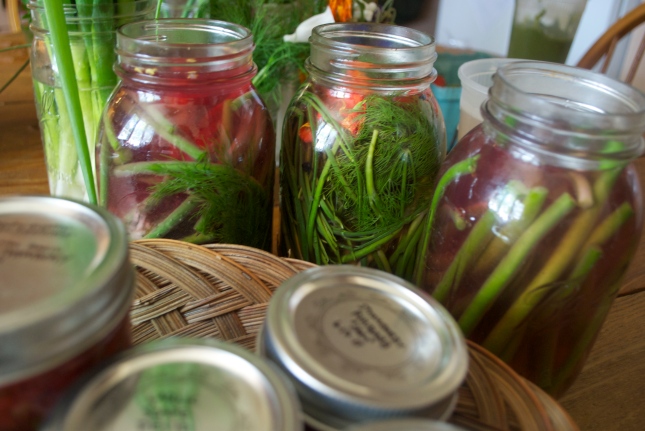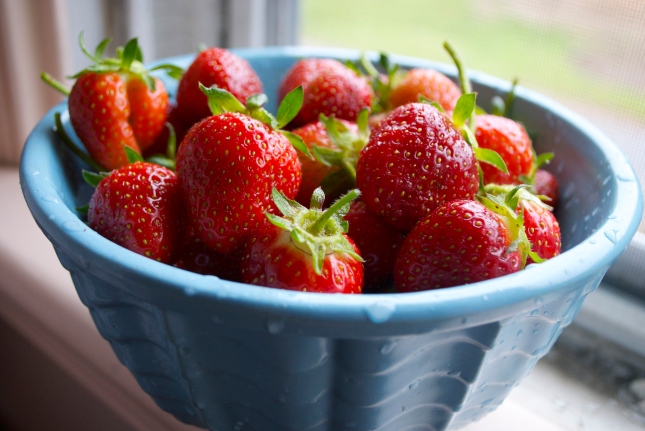Does anyone actually like Boca Burgers? Is it possible? Their ingredient list is as follows: WATER, SOY PROTEIN CONCENTRATE, WHEAT GLUTEN, CONTAINS LESS THAN 2% OF METHYLCELLULOSE, SALT, CARAMEL COLOR, DRIED ONIONS, YEAST EXTRACT, SESAME OIL, HYDROLYZED WHEAT PROTEIN, NATURAL AND ARTIFICIAL FLAVOR (NON-MEAT), DISODIUM GUANYLATE, DISODIUM INOSINATE. CONTAINS: SOY, WHEAT, SESAME.
I feel nauseous. And let’s be honest here, most veggie burgers you eat at restaurants aren’t much better. Black bean burger anyone? Some ketchup for your soy? Isn’t a veggie burger supposed to have, you know, vegetables?
I’m here to tell you that yes it can! And it can taste great! And be a complete source of protein, fiber, carbs, vitamins and minerals! What more can you ask for?? Given the lack of leftovers at lunch this week, not too much, it seems.
On the menu this week: Mushroom burgers (I’d made them after visiting Dave in Bridgehampton), roasted garlic scape pesto, quick pickled carrots & radishes, and crispy scallions. I made all the fixings (and a salad, dressing, and a side of sautéed snap peas) in under an hour. So read on, don’t be afraid! You, too, can learn the art of the veggie burger! Here’s the recipe I provided to our CSA this week, followed by some additional notes and suggestions:
For the veggie burgers, you’re looking for something with a great flavor, that holds together when cooked, and has some texture. To achieve this delicate balance, you need a few things:
Vegetables: Alliums (onions, scallions, shallots, leeks, garlic, etc) are a must, as they bring out the savory flavor in foods. Other go to veggies that have a savory, earthy flavor include mushrooms, eggplant, and squash.
Legumes: Add a nice texture and starchiness, and of course are a great source of protein and other nutrients. I like to use chickpeas or lentils, which are a bit more flavor neutral than cannellini or black beans.
Grains: These are important to hold the burger together. You can use almost anything you’d like, knowing that you’ll need to put it in the food processor to make it work. Bread crumbs are a great way to hold everything together, as you’ll inevitably find your “dough” is too sticky. I’ve recently turned to psyllium husk, which is a great high-fiber, gluten-free ingredient that works as an amazing binder.
Nuts/Seeds: These add crucial fats and great texture to the burger. Stick to more unassertive flavors like sunflower seeds, cashews or pine nuts.
Herbs/Spices: Use them! They add so much flavor and wonderful nutrients to your burgers. You should be able to eat your dough with a spoon and thoroughly enjoy it. Parsley goes with everything. Do not forget salt and pepper. And go for a little lemon juice if things seems dull.
To achieve the perfect texture that holds together, here’s my trick. Cook all your vegetables. Cook your legume. Cook your grain. Mix it all together. Take between 2/3 and 3/4 of that mix, and put it into your food processor or blender. Process until just a few chunks remain. Mix that back in with the whole veggies, legumes and grains. Then add in any herbs, spices, or fresh vegetables. And finally add in bread crumbs or psyllium to get the right moisture for patty-making.
Veggie burgers can be cooked in the oven, pan-fried, or on the grill. I’ve never had a problem getting a nice crust on my burgers in the oven – I just make sure the pan is hot before putting the burgers on it (just put it in the oven while its preheating with a bit of oil).
And don’t think mushrooms and rice is all there is! This is the perfect recipe to get creative with. Here are just a few of my flavor suggestions:
Quinoa + Red Bean + Walnut + Ginger/Parsley/Scallion
Butternut Squash + Black Bean + Chestnuts + Spinach
Spinach + Chickpeas + Cumin
Lentils + Kale + Sweet Potato + Garam Masala/Curry Powder/Cilantro
Corn + Polenta + Sun Dried Tomatoes + Goat Cheese
Eggplant + Rice + Tomato + Cilantro/Curry Powder/Garam Masala
Black Beans + Rice + Allspice + Nutmeg + Jalapeno
What can I say…I’ve done a lot of experimenting…And I hope you will too!














